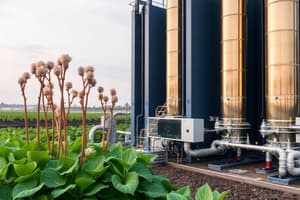Podcast
Questions and Answers
What is the primary difference between indirect and direct carbon sequestration?
What is the primary difference between indirect and direct carbon sequestration?
- Indirect sequestration depends on natural processes, while direct sequestration involves human-controlled processes. (correct)
- Direct sequestration utilizes natural processes to capture CO2.
- Direct sequestration is always more effective than indirect sequestration.
- Indirect sequestration involves human manipulation of CO2.
Which process is fundamental to indirect carbon sequestration involving plants?
Which process is fundamental to indirect carbon sequestration involving plants?
- Respiration
- Photosynthesis (correct)
- Transpiration
- Fermentation
What are the two methods of forest-based indirect carbon sequestration?
What are the two methods of forest-based indirect carbon sequestration?
- Conservation and rewilding
- Cultivation and irrigation
- Afforestation and reforestation (correct)
- Harvesting and restoration
What is the by-product of the photosynthesis reaction?
What is the by-product of the photosynthesis reaction?
What is the energy source required for photosynthesis?
What is the energy source required for photosynthesis?
What happens during geological storage of CO2?
What happens during geological storage of CO2?
How much energy is required for the photosynthesis of one molecule of CO2?
How much energy is required for the photosynthesis of one molecule of CO2?
Which of the following is NOT a method of indirect carbon sequestration?
Which of the following is NOT a method of indirect carbon sequestration?
Flashcards
Indirect Carbon Sequestration
Indirect Carbon Sequestration
A method of carbon capture that doesn't require direct human intervention, relying on natural processes like plant growth to absorb CO2.
Direct Carbon Sequestration
Direct Carbon Sequestration
A method of carbon capture actively separating CO2 from combustion products and storing it elsewhere.
Afforestation
Afforestation
Planting of forests in areas where they didn't previously exist.
Reforestation
Reforestation
Signup and view all the flashcards
Photosynthesis
Photosynthesis
Signup and view all the flashcards
Geological Storage
Geological Storage
Signup and view all the flashcards
Carbon Capture
Carbon Capture
Signup and view all the flashcards
CO2
CO2
Signup and view all the flashcards
Study Notes
Carbon Capture and Storage (CCS) Systems
- CCS is a method for capturing CO2 emissions and storing them, preventing them from entering the atmosphere.
- Two main categories of sequestration exist: indirect and direct.
Indirect Sequestration
- Indirect sequestration does not control CO2 directly.
- It fosters natural processes like CO2 absorption by plants to increase CO2 removal rates.
- Forest management, including afforestation and reforestation, are parts of this approach.
Indirect Sequestration - Forest-Based
- Forest-based sequestration includes afforestation (planting trees in previously unforested land) and reforestation (replanting areas where forests have been lost).
- Data for 2020 shows varying annual forest area changes globally . Changes range from a loss of 0.3% in Brazil to gains of over 0.9% in certain Asian regions.
The Photosynthesis Reaction (Indirect Sequestration)
- Plants use photosynthesis to convert CO2 and water into glucose (stored energy) and release oxygen.
- The energy source for this process is sunlight.
- The amount of energy needed per CO2 molecule is 9.47 x 10⁻¹⁹ J.
Direct Sequestration
- Direct sequestration is human-controlled.
- This involves separating CO2 from combustion byproducts and storing it in designated geological locations. This is called geological storage.
Direct Sequestration - Geological Storage
- Steps involved in geological storage:
- Removal of CO2 from combustion byproducts.
- Storing CO2 in subsurface geological formations (like depleted oil and gas reservoirs or saline formations).
- This storage should be secure to avoid future release.
Direct Air Capture (DAC)
- Direct Air Capture (DAC) is another form of direct sequestration.
- DAC involves capturing CO2 directly from the atmosphere.
- A DAC facility sequesters atmospheric CO2, stores it, and converts some of it to transportation fuels.
Studying That Suits You
Use AI to generate personalized quizzes and flashcards to suit your learning preferences.





